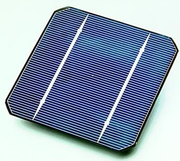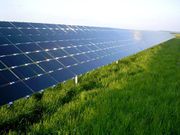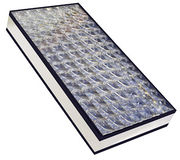Knowledge fuels change
For over a decade, Energypedia has shared free, reliable energy expertise with the world.
We’re now facing a serious funding gap.
Help keep this platform alive — your donation, big or small, truly matters!
Thank you for your support
Solar Cells and Modules
Overview
A solar cell or photovoltaic (PV) cell is a semiconductor device that converts light directly into electricity by the photovoltaic effect. The most common material in solar cell production is purified silicon that can be applied in different ways.
Monocrystalline Silicon Photovoltaic (PV) Cells
Monocrystalline silicon PV cells are made from silicon wafers that are cut from cylindrical single-crystal silicon ingots. The rotund cells have to be cut to form nearly quadratic cells, that can be easily <g class="gr_ gr_197 gr-alert gr_gramm gr_inline_cards gr_run_anim Grammar multiReplace" id="197" data-gr-id="197">integrated in</g> one module. Thus, refined silicon is wasted in the cell production process. Monocrystalline silicon shows predictable and uniform <g class="gr_ gr_200 gr-alert gr_spell gr_inline_cards gr_run_anim ContextualSpelling multiReplace" id="200" data-gr-id="200">behaviour</g>, but, due to the careful and slow manufacturing processes required, it is also the most expensive type of silicon.
Modules consisting of monocrystalline silicon PV cells reach commercial efficiencies between 15 and 18 %. So far, they are the most efficient modules and, with about 85% in 2010, have the largest market share. However, other alternatives are challenging this technology.
Polycrystalline Silicon Photovoltaic (PV) Cells
Polycrystalline or <g class="gr_ gr_229 gr-alert gr_spell gr_inline_cards gr_run_anim ContextualSpelling ins-del multiReplace" id="229" data-gr-id="229">multicrystalline</g> silicon PV cells are made from cast square ingots — large blocks of molten <g class="gr_ gr_238 gr-alert gr_gramm gr_inline_cards gr_run_anim Punctuation only-del replaceWithoutSep" id="238" data-gr-id="238">silicon,</g> carefully cooled and solidified. They are less expensive to produce than monocrystalline silicon PV cells, but are marginally less efficient, with module conversion efficiencies between 13 and 16 %.
-> PVCDROM.org, an educational website on photovoltaics, shows the production process of polycrystalline silicon PV cells with pictures <g class="gr_ gr_265 gr-alert gr_gramm gr_inline_cards gr_run_anim Style multiReplace" id="265" data-gr-id="265">and </g><g class="gr_ gr_266 gr-alert gr_gramm gr_inline_cards gr_run_anim Style multiReplace" id="266" data-gr-id="266"><g class="gr_ gr_265 gr-alert gr_gramm gr_inline_cards gr_disable_anim_appear Style multiReplace" id="265" data-gr-id="265">video</g> sequences</g>.
Thin Film Photovoltaic (PV) Cells
The various thin film technologies currently being developed reduce the amount (or mass) of light absorbing material required in creating a solar cell. This can lead to reduced processing costs from that of bulk materials (in the case of silicon thin films) but also tends to reduce energy conversion efficiency (an average 6 to 12 % module efficiency).[1]
Thin film PV cells are constructed by depositing extremely thin layers of photovoltaic <g class="gr_ gr_137 gr-alert gr_spell gr_inline_cards gr_run_anim ContextualSpelling ins-del" id="137" data-gr-id="137">semi-conductor</g> materials onto a backing material such as glass, stainless steel or plastic. Thin film materials commercially used are amorphous silicon (a-Si), cadmium telluride (CdTe), and copper-indium-(gallium)-diselenide (CI(G)S).[1]
Commercially available thin film modules:
- Are potentially cheaper to manufacture than crystalline cells
- Have a wider customer appeal as design elements due to their homogeneous appearance
- Present disadvantages, such as low-conversion efficiencies and requiring larger areas of PV arrays and more material (cables, support structures) to produce the same amount of electricity
Third Generation Solar Cells
<g class="gr_ gr_169 gr-alert gr_gramm gr_inline_cards gr_run_anim Punctuation only-ins replaceWithoutSep" id="169" data-gr-id="169">Currently</g> there are solar cells based <g class="gr_ gr_136 gr-alert gr_gramm gr_inline_cards gr_run_anim Grammar multiReplace" id="136" data-gr-id="136">in</g> different new technologies in the way to market maturity, for <g class="gr_ gr_168 gr-alert gr_gramm gr_inline_cards gr_run_anim Punctuation only-ins replaceWithoutSep" id="168" data-gr-id="168">example</g> the <g class="gr_ gr_170 gr-alert gr_spell gr_inline_cards gr_run_anim ContextualSpelling multiReplace" id="170" data-gr-id="170">high efficiency</g> cells:
Thin film III-V solar cells:
- <g class="gr_ gr_162 gr-alert gr_spell gr_inline_cards gr_run_anim ContextualSpelling ins-del multiReplace" id="162" data-gr-id="162">nion</g> of the semiconductors from the third and the fifth group from the periodic table.
- Efficiency of 20-25% [2]
- A variety of possible combination increasing price while increasing efficiency
- Most common connection: gallium arsenide (GaAs),
- Application: Power supply of satellites
Multi-stack thin film:
- "Stacking" III-V solar cells or silicon cells
- Efficiency up to approximately 37% [2]- Each cell absorbs a certain wavelength, and then the stack can absorb more from the solar spectrum
- The top cell material has the highest band gap and covers the highest absorption area. Underlying cells <g class="gr_ gr_175 gr-alert gr_gramm gr_inline_cards gr_run_anim Grammar multiReplace" id="175" data-gr-id="175">absorbs</g> the section of the solar spectrum with smaller wavelengths.
- Series connection of the overlying cells
- Other names for <g class="gr_ gr_154 gr-alert gr_spell gr_inline_cards gr_run_anim ContextualSpelling ins-del multiReplace" id="154" data-gr-id="154">mutli</g>-stack solar cells (depending on the number of layers) <g class="gr_ gr_155 gr-alert gr_gramm gr_inline_cards gr_run_anim Punctuation only-del replaceWithoutSep" id="155" data-gr-id="155">are:</g> Tandem, triple, or multiple cascade cells.
Concentrator <g class="gr_ gr_173 gr-alert gr_spell gr_inline_cards gr_run_anim ContextualSpelling ins-del multiReplace" id="173" data-gr-id="173">Photovolatics</g>
|
Concentrator photovoltaics (CPV) <g class="gr_ gr_171 gr-alert gr_gramm gr_inline_cards gr_run_anim Grammar multiReplace" id="171" data-gr-id="171">are</g> based on lenses or mirrors which focus direct sun light on solar cells. These cells consist of a small amount of highly efficient, but expensive, PV-material (silicon or III-V compounds, generally gallium arsenide or <g class="gr_ gr_174 gr-alert gr_spell gr_inline_cards gr_run_anim ContextualSpelling ins-del multiReplace" id="174" data-gr-id="174">GaA</g>). In <g class="gr_ gr_150 gr-alert gr_gramm gr_inline_cards gr_run_anim Punctuation only-ins replaceWithoutSep" id="150" data-gr-id="150">order</g> the course of the sun Concentrator modules <g class="gr_ gr_149 gr-alert gr_gramm gr_inline_cards gr_run_anim Grammar multiReplace" id="149" data-gr-id="149">are</g> mounted on a 2-axis tracking system. In <g class="gr_ gr_152 gr-alert gr_gramm gr_inline_cards gr_run_anim Grammar only-ins doubleReplace replaceWithoutSep" id="152" data-gr-id="152">case</g> of low-concentration-PV there exist 1-axis tracking <g class="gr_ gr_156 gr-alert gr_spell gr_inline_cards gr_run_anim ContextualSpelling ins-del multiReplace" id="156" data-gr-id="156">systens</g> and less complex lenses. |
Organic Solar Cells
Hybrid dye-sensitised solar cells:
instead of <g class="gr_ gr_148 gr-alert gr_spell gr_inline_cards gr_run_anim ContextualSpelling ins-del" id="148" data-gr-id="148">semi-conductor</g> material hybrid <g class="gr_ gr_205 gr-alert gr_gramm gr_inline_cards gr_run_anim Punctuation only-ins replaceWithoutSep" id="205" data-gr-id="205">dye-sensitised</g> solar cells use an organic dye for light absorption. Simple silk-screen allows cost-efficient production costs and offers different scopes for design as implementation in frontages or <g class="gr_ gr_135 gr-alert gr_gramm gr_inline_cards gr_run_anim Grammar multiReplace" id="135" data-gr-id="135">in</g> advertising <g class="gr_ gr_209 gr-alert gr_gramm gr_inline_cards gr_run_anim Style multiReplace" id="209" data-gr-id="209">purposes </g>[5]<g class="gr_ gr_209 gr-alert gr_gramm gr_inline_cards gr_disable_anim_appear Style multiReplace" id="209" data-gr-id="209">.</g> hybrid dye-sensitised solar cells are able to use diffuse sun light. Average efficiencies vary from 2 to 4%.
Fully organic solar cells:
Organic solar cells are still at an early stage of development. These cells consist of organic hydrocarbon compounds as well as a special electron structure and are able to generate electricity on foils and textiles. At present average <g class="gr_ gr_203 gr-alert gr_gramm gr_inline_cards gr_run_anim Punctuation only-ins replaceWithoutSep" id="203" data-gr-id="203">cell</g> efficiencies vary between 3 and 5 <g class="gr_ gr_204 gr-alert gr_gramm gr_inline_cards gr_run_anim Style multiReplace" id="204" data-gr-id="204">percent </g>[5]<g class="gr_ gr_204 gr-alert gr_gramm gr_inline_cards gr_disable_anim_appear Style multiReplace" id="204" data-gr-id="204">.</g> Minor material consumption and more efficient production technologies lead to a high potential for cost-efficient production. However, there is still need for research activities as life spans are very short.
Solar Modules
For almost all applications, the one-half volt produced by a single cell is inadequate. Therefore, cells are connected together in series to increase the voltage. Several of these series strings of cells may be connected together in parallel to increase the current as well.[6]
In order to use the connected cells in practical applications they must be:
- protected from mechanical damage during manufacture, transport and installation and use (in particular against hail impact, wind, <g class="gr_ gr_183 gr-alert gr_gramm gr_inline_cards gr_run_anim Punctuation only-ins replaceWithoutSep" id="183" data-gr-id="183">sand</g> and snow loads). This is especially important for wafer-based silicon cells which are brittle.
- protected from moisture, which corrodes metal contacts and interconnects, (and for thin-film cells the transparent conductive oxide layer) thus decreasing performance and lifetime.
Therefore, the interconnected cells and their electrical connections are sandwiched between a top layer of glass or clear plastic and a lower level of plastic or plastic and metal. An outer frame is attached to increase mechanical <g class="gr_ gr_214 gr-alert gr_gramm gr_inline_cards gr_run_anim Punctuation only-del replaceWithoutSep" id="214" data-gr-id="214">strength,</g> and to provide a way to mount the unit. This package is called a "module" or "panel". Typically, a module is the basic building block of photovoltaic systems.[6]
The peak power output of a solar module depends on the number of cells connected and their size. Module performance is generally rated under Standard Test Conditions (<g class="gr_ gr_190 gr-alert gr_gramm gr_inline_cards gr_run_anim Style multiReplace" id="190" data-gr-id="190">STC)</g><g class="gr_ gr_190 gr-alert gr_gramm gr_inline_cards gr_disable_anim_appear Style multiReplace" id="190" data-gr-id="190"> :</g> irradiance of 1,000 W/m², <g class="gr_ gr_189 gr-alert gr_gramm gr_inline_cards gr_run_anim Grammar only-ins doubleReplace replaceWithoutSep" id="189" data-gr-id="189">solar</g> spectrum of AM 1.5 and module temperature at 25°C. Solar modules are rated in peak watts [Wp] according to their output under STC. Thus, a 50 Wp module can be expected to supply 50 W of power under optimal conditions. The performance is reduced by high temperatures.[6]
Like solar cells modules can be connected in series and/or in parallel to increase the voltage and/or the current depending on the system requirements.[6]
Comparison of Different Types of PV Modules
Comparison of Different Types of PV Modules[7][8]:
| Cell material | Module efficiency | Surface area needed for 1 kWp | Advantages | Disadvantages |
| Monocrystalline silicon | 15-18 % | 7-9 m² | - most efficient PV modules - easily available on the market - highly standardised |
- most expensive - waste of silicon in the production process |
| Polycrystalline silicon | 13-16 % | 8-9 m² | - less energy and time needed for production than for monocrystalline cells (= lower costs) - easily available on the market - highly standardised |
- slightly less efficient than monocrystalline silicon modules |
| Micromorph tandem (aµ-Si) | 6-9 % | 9-12 m² | - more space for the same output needed | |
| Thin film: Copper indium diselenide (CIS) |
10-12 % | 9-11 m² | - higher temperatures and shading have lower impact on performance - lower production costs |
- more space for the same output needed |
| Thin film: Cadmium telluride (CdTe) |
9-11 % | 11-13 m² | - higher temperatures and shading have lower impact on performance - highest cost-cutting potential |
- more space for the same output needed |
| Thin film: <g class="gr_ gr_212 gr-alert gr_spell gr_inline_cards gr_run_anim ContextualSpelling ins-del multiReplace" id="212" data-gr-id="212">Amorphus</g> silicon (a-Si) |
6-8 % | 13-20 m² | - higher temperatures and shading have lower impact on performance - less silicon needed for production |
- more space for the same output needed |
To compare the price of the different modules, the next database present monthly updated values: solarserver.de
Due to their high efficiency, market penetration and <g class="gr_ gr_188 gr-alert gr_spell gr_inline_cards gr_run_anim ContextualSpelling multiReplace" id="188" data-gr-id="188">standardisation</g> mono- and polycrystalline silicon modules are the most common modules used in solar home systems (SHS). However, the market share of thin film modules is growing, especially in <g class="gr_ gr_151 gr-alert gr_spell gr_inline_cards gr_run_anim ContextualSpelling ins-del" id="151" data-gr-id="151">free-standing</g> and building integrated PV systems.
Further Information
- Solar Portal on energypedia
- Further information on PV modules in solar home systems see standards for the PV generator.
- Further information <g class="gr_ gr_138 gr-alert gr_spell gr_inline_cards gr_run_anim ContextualSpelling ins-del multiReplace" id="138" data-gr-id="138">abou</g> solar cells its applications and history: Célula Solar Fotovoltaica
References
- ↑ 1.0 1.1 IEA PVPS, http://www.iea-pvps.org/pv/snapshot/techproc.htm
- ↑ 2.0 2.1 http://www.cie.unam.mx/~rbb/Razykov_20011_PV_SolarEnergy.pdf Cite error: Invalid
<ref>tag; name "CIE 2011" defined multiple times with different content - ↑ EPIA11: http://www.epia.org/publications/photovoltaic-publications-global-market-outlook.html
- ↑ Fraunhofer 09: http://www.vision.fraunhofer.de/de/projekte/465.html
- ↑ 5.0 5.1 Jäger11: http://www.gtz.de/de/dokumente/giz2011-de-Potentialstudie-Marokko-PV.pdf
- ↑ 6.0 6.1 6.2 6.3 Polar Power Inc., http://polarpowerinc.com/home.htm
- ↑ Solarpraxis (Hrsg.): Photovoltaik für Profis. Verkauf, Planung Montage von Solarstromanlagen, 2., vollständig überabeitete Auflage, 2009, S. 131-135.
- ↑ EPIA11: http://www.epia.org/publications/photovoltaic-publicationsglobal- market-outlook.html






















